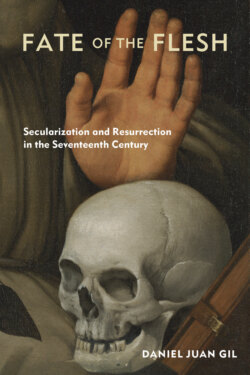Fate of the Flesh

Реклама. ООО «ЛитРес», ИНН: 7719571260.
Оглавление
Daniel Juan Gil. Fate of the Flesh
CONTENTS
PREFACE: CHRISTIANITY AS CRITICAL THEORY
Introduction: Secularization and the Resurrection of the Flesh
1 / Secularization, Countersecularization, and the Fate of the Flesh in Donne
2 / Wanting to Be Another Person: Resurrection and Avant-Garde Poetics in George Herbert
3 / Luminous Stuff: The Resurrection of the Flesh in Vaughan’s Religious Verse
4 / The Feeling of Being a Body: Resurrection and Habitus in Vaughan’s Medical Writings
5 / Resurrection, Dualism, and Legal Personhood: Bodily Presence in Ben Jonson
Epilogue: Resurrection and Zombies
ACKNOWLEDGMENTS
NOTES. Preface: Christianity as Critical Theory
Introduction: Secularization and the Resurrection of the Flesh
1 / Secularization, Countersecularization, and the Fate of the Flesh in Donne
2 / Wanting to Be Another Person: Resurrection and Avant-Garde Poetics in George Herbert
3 / Luminous Stuff: The Resurrection of the Flesh in Vaughan’s Religious Verse
4 / The Feeling of Being a Body: Resurrection and Habitus in Vaughan’s Medical Writings
5 / Resurrection, Dualism, and Legal Personhood: Bodily Presence in Ben Jonson
Epilogue: Resurrection and Zombies
INDEX
Отрывок из книги
FATE OF THE FLESH
—R. G. COLLINGWOOD
.....
Precisely for these reasons, I argue, Peter Bürger’s account of the avant-garde is a powerful model for understanding the art of Donne, Herbert, Vaughan, and Jonson. For Bürger, early twentieth-century avant-garde art is the culmination and also the critique of a historical development in which art is defined as an autonomous domain and is characterized by closed, beautiful, and representational works of art that stand apart from social life and therefore have no implications for social praxis or how people live. Bürger argues that the avant-garde artists both recognize this development and actively turn against it, using violent techniques to wrench art out of its autonomous apartness and return it to social life. Bürger argues that avant-garde art is driven by the impulse to break down the wall between art and everyday life and to see art as an alternative kind of social praxis, an opportunity to engage in new forms of social experience and connection. Thus, for Bürger, avant-gardism challenges the sacred apartness of art, forcing art back into the world by creating visceral, sometimes deranging experiences in readers and creating communities around such experiences even (or especially) when they are hostile to traditional canons of beauty and to the traditional artistic function of representation.33 Bürger writes:
The avant-garde not only negates the category of individual production but also that of individual reception.… Given the avant-gardist intention to do away with art as a sphere that is separate from the praxis of life, it is logical to eliminate the antithesis between producer and recipient.… Producers and recipients no longer exist. All that remains is the individual who uses poetry as an instrument for living one’s life as best one can.
.....